I visited A la Ronde during my recent stay in Exmouth, Devon. I was much intrigued by this sixteen-sided round house, which provided a source of fascination for me.
Built for the independently rich spinster cousins, Jane and Mary Parminter, in 1796, it is thought to have been inspired by the sixth century Byzantine basilica of San Vitale at Ravenna, Italy.
Jane- the daughter of a successful Lisbon wine merchant- and her cousin were able to embark on a ten year grand tour of the continent in the late 18th century. They returned to England in 1795 and decided to build a new house in Exmouth, which would remind them of their experiences and allow them to house their collection of souvenirs.
It was a cloudy but pleasant day when we caught the bus which took us directly to this National Trust building.
The first thing we saw was this water-tower and wash house, which was introduced by the only male to own A la Ronde, Rev. Oswald Reichel. He also attempted more modernisation; by replacing the thatched roof with tiles, installing central heating, converting the attic into rooms with dormer windows and by adding an external catwalk.
Built for the independently rich spinster cousins, Jane and Mary Parminter, in 1796, it is thought to have been inspired by the sixth century Byzantine basilica of San Vitale at Ravenna, Italy.
Jane- the daughter of a successful Lisbon wine merchant- and her cousin were able to embark on a ten year grand tour of the continent in the late 18th century. They returned to England in 1795 and decided to build a new house in Exmouth, which would remind them of their experiences and allow them to house their collection of souvenirs.
It was a cloudy but pleasant day when we caught the bus which took us directly to this National Trust building.
The first thing we saw was this water-tower and wash house, which was introduced by the only male to own A la Ronde, Rev. Oswald Reichel. He also attempted more modernisation; by replacing the thatched roof with tiles, installing central heating, converting the attic into rooms with dormer windows and by adding an external catwalk.
Jane died in 1811 and, when Mary died in 1849, her will specified that only unmarried kinswomen could inherit the house, until changes in property law allowed Reichel to take up ownership in the 1890s.
This sink looked massive. Both myself and Dean can remember being washed in similar butler's sinks as children.
You have to enter through the gift shop, and this was our first view of the garden, with its lady-in-dishabille statue sitting just to the left of the first tree.. The River Exe is in the misty background.
Our first view of the house was none too impressive, as it's currently hidden underneath scaffolding, as essential work to fix the leaky roof is taking place.
The view from the garden, taken whilst standing just below the ha-ha...
The view from a distance. You do get a general idea of the shape of the building from this photo...
This is a PDF showing what the building looks like without scaffolding.
Oh well, there's my excuse to return sorted...😉
You enter via The Hall, which is quite gloomy, considering that the building was designed to maximise sunlight opportunities.
The Study contains information about the house and its bareness lets you see exactly how these interesting room were formed. To the right we have a pensive SuperDean by the door. The doors were originally designed to slide back into the fabric of the house, although most of these have either been altered or blocked.
These diamond-shaped windows are a spectacular addition...
This shows how the blinds work. Although A la Ronde is considered to be a fine example of Regency architecture, something about these windows reminds me of 1960s pop art...
The top picture depicts Jane and Mary's A la Ronde and the bottom sketch shows how the house was altered by Oswald Reichel, in the 1890s.
The Vain Old Tart and a pensive SuperDean...
Here we have another Vain Old Tart shot. I'm wearing a top hat as dressing-up costumery was available. On the wall to the right is the floor plan of this unusual building.
Music Room fireplace...
The carved oak desk is English and is 17th century...
Flash photography wasn't allowed, so this shot of the mid 19th century walnut boudoir grand piano is in silhouette...
One of several little nooks between the rooms. This nook contained books. Note the octagonal bowl- a lot of thought has gone into the continuity of the theme of the furnishings, although not all of them are old and from the Parminter cousins'- or indeed Oswald Reichel's- time.
In The Library. This is actually the centre of a book case, which houses books belonging to the Parminters and which is lined with Italian gouaches and prints. It contains family souvenirs such as shells, beadwork, votive statues and semi-precious stones.
It is a rare surviving 'cabinet of curiosities'...
Oswald Reichel's books are in the cabinet by the fireplace...
This model of A la Ronde is by Lucius Reichel (brother of Oswald) and dates from the mid 19th century.
This glass dome contains 29 miniature school textbooks...
Two views of A la Ronde. The earliest is a lithograph, entitled, Cottage near Exmouth...
These curving stairs were added in the 20th century. Up we went...
The view over the Exe Estuary and Haldon Hill was somewhat marred by the scaffolding. The view from the bus on the way in was magnificent. As the river is below the height of the road, and mist was lifting upwards over the hills, it actually looked like we were travelling above the level of the clouds.
The house abounds with more modern arts and crafts touches, in keeping with the creative theme of the ladies' hobbies. This was in a cranny of the bedroom.
The Parminters did not sleep upstairs. This room was converted into a bedroom by Reichel.
Bedroom fireplace...
I'm sure I read that this horrible looking contraption was a saddle. It looks none too comfortable!
Shell cabinets from the Mellows Shell Room and Corridor.
Mrs Mellows of London donated a collection of shells, which is an amalgamation of three 19th century collections gathered from all over the world...
More shells, in keeping with the theme...
...And more!
This cabinet was inserted into a wall of the corridor...
The upstairs corridor; and this photo gives you some idea of the shape...
The khazi and a bed pan. I had to be gross (and base!) and get a photo of this...
The old-fashioned toilet cistern. I remember these from my school days. They used to terrify me- I was scared that the whole contraption was going to fall down and crown me!
Dean fascinated by what appeared to be an old gas flue...
The bath...
The washbasin...
This is as close as we were allowed to get to the Shell Gallery. It's been closed to visitors for almost 20 years (for some reason, the year 2002 rings a bell- it must have been referenced in the house, as I can see no mention of that date on any website or in their tourist brochure...)
This area is quite precarious. This stained timber staircase was added by Oswald Reichel, and a note by the Shell Gallery steps reminds you not to take a step backwards, otherwise you'll fall down these stairs and break your neck...
Modern crafts have been added, such as these cute knitted sunflowers...
A very apt octagonal table at the base of the stairs.
Entering the stunning Octagon, with its chevron wallpaper. It's designed to make you feel that you're in an undersea cave. The core of the house is where (as the name suggests) sixteen sides become eight...
The view upwards. The Shell gallery runs around the walls behind the balcony, and what I could see looked absolutely stunning. The Gallery has suffered from damage caused by both decay and restoration. It will take years before the repairs to this delicate area are completed and, even then, it's unlikely that the Shell Gallery will be open to visitors.
It's such a shame. I've visited the Shell Grotto, Margate; Alexander Pope's Grotto, Twickenham; and Painshill Park, Surrey, which contains the Crystal Grotto.
I would have loved to have been able to have a nosey around this balcony...
This is a PDF, which shows how fantastic this gallery is.
The Parminter ladies stuck shells, feathers, glass, pottery, stones, mirrors, bones and paint onto card, then simply attached their creations to the wall by pressing them into the lime putty which sat on top of the coarse plaster walls. Birds feature in their designs, as does a crown, which was in honour of George III.
The attention to detail here is immense. These chairs continue with the octagon theme...
Fireplace of shells (note: if you don't like shells, don't come here!)
The Drawing Room was created when the Misses Parminter's two bedrooms were knocked into one room, by Oswald Reichel. He wanted to create a drawing room to satisfy the needs of a Victorian gentleman.
The frieze in this room was skilfully created by the Parminters, and contains feathers stuck down with isinglass into concentric circular patterns.
It was not uncommon for 18th century ladies to practise crafts such as needlework, drawing, japanning, gilding and making pictures out of unusual objects.
This paper flower parlour dome is dated... 2019!
The window bay contains a rare mahogany-cased mechanical piano, dated approximately 1810.
Above the fireplace is a large silhouette group drawing by Francois Torond (1742-1812).
Tapestry pictures, shell pictures and sketches by the cousins abound in this area...
The Dining Room fireplace...
The dining table and chairs are late Georgian...
Implements for the making of afternoon tea...
This corner gives you some idea of the state of disrepair in parts of the house...
This is known as the lamp room, but was once the scullery and servery. It contains yet more shells, this time larger and clunkier. Some of these are a recently donated shell collection, but the top shelf includes sea urchins and snails from the Mellows Collection.
This room also has an interactive screen, where you can move around and get a 'close-up' 360° view of the shell gallery.
This room also has an interactive screen, where you can move around and get a 'close-up' 360° view of the shell gallery.
That was the tour of the house complete, so we ventured out to the garden seating area. But we were sensible- the day was not brilliantly warm, so we had our cream tea inside the cafe, which was just charming.
The sloping view downwards toward the river. By now, the clouds were lifting and the contrasting colours of the scenery made for a good photo opportunity.
Mushrooms beginning to form a magic circle. It's a very apt analogy- there is something intrinsically magical about this place...
The top of the ha-ha
Bottom of the ha-ha...
If there were bees in here, they (thankfully, I don't much like the little sods) were showing no signs of activity when I rocked up...
Walking around the meadow, and this is the Centenary Obelisk. It was erected by the National Trust, who acquired A la Ronde in 1991. If you stand here and look right, you can enjoy a panoramic view over the Exe Estuary. I couldn't help but note that this tower is octagonal!
Majestic trees are dotted around the garden, but I'll refrain from adding all my photos of them- I've told myself I'm going to be good, and more selective with regard to which photos I post!
More outside seating.
Family tradition states that Jane desgned A la Ronde herself. A 19th century writer mentions that the house was built 'from plans by a Mr Lowder'. It's likely that theory is true- a relative by marriage of Mary Parminter was called John Lowder, and he was a Commander-turned-property-developer. He also had a son of the same name, who practised as a gentleman architect, so it's likely that it was him, even though he was still a teenager at the time. This is completely plausible- architects were often apprenticed at the age of fifteen.
Tap and watering can...
The building to the left houses the shop, through which visitors enter. It was formerly a coachman's cottage and stables. Until recently the front door of the house was attached to the cottage by means of a Victorian glazed corridor.
The magnificent, bucolic view over the River Exe. Exmouth was becoming a fashionable area in the late 18th century, and had begun to attract 'some persons of condition'. It was also recommended to the cousins for its clement climate.
Jane and Mary Parminter were in good company- Lord Nelson's estranged wife, Frances, lived in the area, as did Lady Byron, the poet George Crabbe, former Prime Minister Lord Bute and Mrs Clarke, mistress of the Duke of York. Jane's sister, Marianne, also lived nearby.
As we left the question we got asked by the lady at the entrance desk was, 'Could you live here?' It was a resounding yes from me! Round houses, such as Jonathan Creek's converted windmill in the eponymous TV series have always impressed me as they are outside the norm- and therefore right up my street.
I first read the James Herbert novel The Magic Cottage when it was serialised (alongside a rather brilliant illustration of the circular cottage) in my mum's Woman magazine. I think this would have been about 1986/7. (I later bought and read the book as an adult although, not being a hoarder, I am no longer in possession of it.) Gramarye, the enchanted cottage of the equation really struck a chord with me. Am I being romantic? Well, I don't think so, as events which took place at said cottage were not all great...
But I'd definitely love to live in a round house (not too far off the beaten track as I don't drive).
Maybe... When I'm a successful, famous author...😀
TTFN
The Miss Elaineous
XXXXXXXXXXXXXXXXX
XXXXXXXXXXX
X











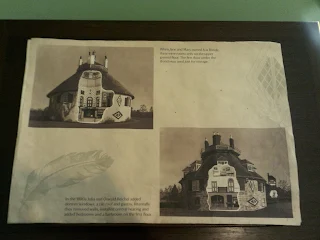
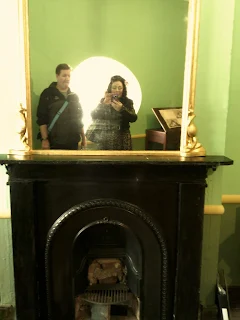

























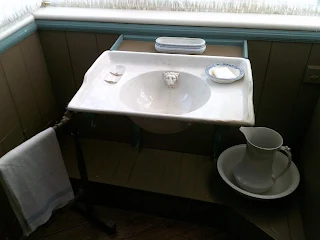







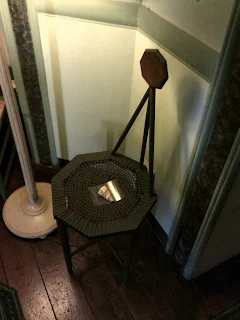























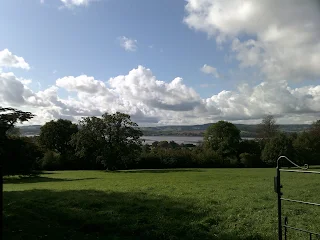


No comments:
Post a Comment